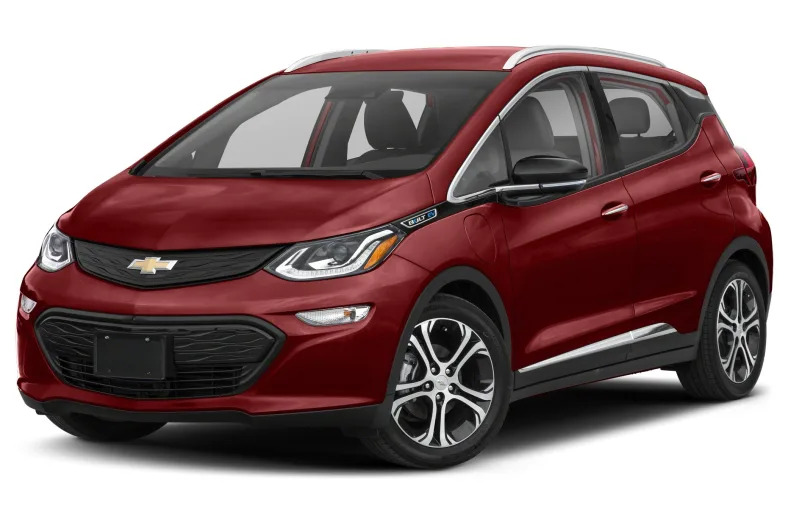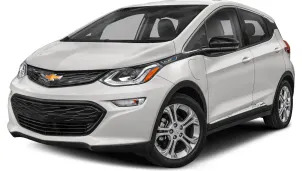Premier 4dr Wagon
2020 Chevrolet Bolt EV
The 2020 Chevrolet Bolt EV hasn’t changed much on the surface since its introduction, but it’s still one of the best long-range electric car values around. It's marketed as a small crossover, but you could fairly call it a compact hatchback. Its range has always been superb, and it gets even better for 2020 with an EPA estimate of 259 miles on a full charge. It also drives well enough, is incredibly roomy inside and is one of the few inexpensive EVs that is (mostly) built in America — its driveline is built in South Korea, but final assembly takes place in Michigan. There are some downsides: the cargo area is small, and the interior materials and fit and finish are disappointing. With new challengers that include the Nissan Leaf Plus, Hyundai Kona Electric and Kia Niro EV, the Bolt's once-formidable range is no longer a unique selling point, but it's still a compelling choice. What's new for 2020? The most important update for the 2020 model year is that new EPA range rating: 259 miles, up by 21 miles compared to the 2019 model. Beyond that, very little has changed. The back-up and surround view cameras have been upgraded to high-definition, and there are two new exterior paint colors — Oasis Blue and Cayenne Orange Metallic. That new blue is no added charge, but the orange falls in the “Premium” paint tier, costing an extra $395. You can read more about the 2020 Bolt changes in our first drive review. What are the Chevy Bolt's interior and in-car technology like? The Bolt's interior is remarkably packaged, emphasizing passenger space at the expense of cargo room. Four adults can fit comfortably inside, and there's enough room for an adult to sit up front with a large rear-facing child seat behind. That said, the cargo area's size and shape may make it difficult for families hoping to haul strollers and other bulky items. The thin front seats can also be unsupportive, with sparse cushioning stretched over a seat frame that can dig into the shoulder blades of some front passengers. The bench-style rear seat isn't very contoured and can be tiring to sit in for long stretches. That said, the low front sills make stepping into the Bolt a breeze, and the high greenhouse is surprisingly airy. In terms of quality, the cabin materials and fit and finish are lower than even the disappointing GM norm – hard plastics, large gaps and rough edges. It looks OK, but there are nicer environments found in the Hyundai Kona, Kia Niro and Nissan Leaf. The Bolt, as mentioned above, doesn't offer onboard navigation, which makes using a smartphone virtually a requirement if there's a chance you'll need to find a charging station along an unfamiliar route. The 10.2-inch touchscreen is big and bright, as is the crisp instrument panel. It offers many of the EV-specific features, like energy consumption, that you'd expect. Apple CarPlay and Android Auto are also included, and OnStar is …
Full Review
The 2020 Chevrolet Bolt EV hasn’t changed much on the surface since its introduction, but it’s still one of the best long-range electric car values around. It's marketed as a small crossover, but you could fairly call it a compact hatchback. Its range has always been superb, and it gets even better for 2020 with an EPA estimate of 259 miles on a full charge. It also drives well enough, is incredibly roomy inside and is one of the few inexpensive EVs that is (mostly) built in America — its driveline is built in South Korea, but final assembly takes place in Michigan. There are some downsides: the cargo area is small, and the interior materials and fit and finish are disappointing. With new challengers that include the Nissan Leaf Plus, Hyundai Kona Electric and Kia Niro EV, the Bolt's once-formidable range is no longer a unique selling point, but it's still a compelling choice. What's new for 2020? The most important update for the 2020 model year is that new EPA range rating: 259 miles, up by 21 miles compared to the 2019 model. Beyond that, very little has changed. The back-up and surround view cameras have been upgraded to high-definition, and there are two new exterior paint colors — Oasis Blue and Cayenne Orange Metallic. That new blue is no added charge, but the orange falls in the “Premium” paint tier, costing an extra $395. You can read more about the 2020 Bolt changes in our first drive review. What are the Chevy Bolt's interior and in-car technology like? The Bolt's interior is remarkably packaged, emphasizing passenger space at the expense of cargo room. Four adults can fit comfortably inside, and there's enough room for an adult to sit up front with a large rear-facing child seat behind. That said, the cargo area's size and shape may make it difficult for families hoping to haul strollers and other bulky items. The thin front seats can also be unsupportive, with sparse cushioning stretched over a seat frame that can dig into the shoulder blades of some front passengers. The bench-style rear seat isn't very contoured and can be tiring to sit in for long stretches. That said, the low front sills make stepping into the Bolt a breeze, and the high greenhouse is surprisingly airy. In terms of quality, the cabin materials and fit and finish are lower than even the disappointing GM norm – hard plastics, large gaps and rough edges. It looks OK, but there are nicer environments found in the Hyundai Kona, Kia Niro and Nissan Leaf. The Bolt, as mentioned above, doesn't offer onboard navigation, which makes using a smartphone virtually a requirement if there's a chance you'll need to find a charging station along an unfamiliar route. The 10.2-inch touchscreen is big and bright, as is the crisp instrument panel. It offers many of the EV-specific features, like energy consumption, that you'd expect. Apple CarPlay and Android Auto are also included, and OnStar is …
Hide Full Review
Hide Full Review
Retail Price
$41,020
MSRP / Window Sticker Price
| Engine | |
| MPG | 127 City / 108 Hwy |
| Seating | 5 Passengers |
| Transmission | 1-spd auto |
| Power | 200 @ rpm |
| Drivetrain | front-wheel |
Smart Buy Program is powered by 






